As a business owner or manager, setting objectives that align with your overall business goals is crucial to achieving success. One effective method for setting objectives is through the use of OKRs (Objectives and Key Results). In this article: “Setting Effective Objectives with OKRs: A Complete Guide”, we will discuss how to set effective objectives using OKRs, provide examples of successful OKRs, and give tips for writing specific, measurable, and attainable objectives and key results.
What are OKRs?
Before we dive into setting effective objectives with OKRs, let’s first define what OKRs are. OKRs are a goal-setting framework that helps individuals and teams set and achieve objectives that align with overall business goals. The framework was popularized by Google, but many other successful companies such as Intel and LinkedIn also use OKRs.
The OKR framework is based on setting two main things: Objectives and Key Results. Objectives are the goals you want to achieve, while Key Results are measurable outcomes that show progress towards achieving the objectives. OKRs are typically set for a specific period, such as quarterly or annually, and can be used at both the individual and team levels.
Setting Objectives that Align with Business Goals
When setting objectives using OKRs, it’s important to ensure that they align with your overall business goals. This means that your objectives should be specific and measurable, and should contribute to the success of your business. Here are some tips for setting objectives that align with your business goals:
Understand your Business Goals
Before setting objectives, it’s essential to understand your business goals. This includes both short-term and long-term goals. By understanding your business goals, you can set objectives that will help you achieve them. For example, if your business goal is to increase revenue by 20%, your objective could be to increase sales by 15% in the next quarter.
Be Specific
When setting objectives, it’s important to be as specific as possible. This means that your objectives should be clear and concise, so everyone on your team understands what you’re trying to achieve. For example, instead of setting an objective to “increase sales,” you could set an objective to “increase sales of Product A by 10% in the next quarter.”
Make Objectives Measurable
Your objectives should be measurable so you can track progress and determine whether you have achieved them. To make objectives measurable, you need to set Key Results. These are measurable outcomes that show progress towards achieving the objectives. For example, if your objective is to increase sales of Product A by 10%, your key result could be to “increase website traffic to Product A page by 20% in the next quarter.”
Focus on Results
When setting objectives, focus on results rather than tasks. Objectives should be outcomes that you want to achieve, not tasks that need to be completed. For example, instead of setting an objective to “create a marketing plan,” you could set an objective to “increase brand awareness by 15% in the next quarter.”
Examples of Effective OKRs
To give you a better understanding of how to set effective objectives using OKRs, here are some examples of successful OKRs:
Example 1: Increase Customer Retention
Objective: Increase customer retention by 20% in the next quarter Key Results:
- Reduce customer churn rate by 10%
- Increase customer satisfaction score by 15%
- Offer loyalty program to increase repeat business by 25%
- Launch the product in Q4 with at least 100 pre-orders
Example 3: Improve Sales Performance
Objective: Improve sales performance by 15% in the next quarter Key Results:
- Increase the number of leads generated by 20%
- Improve the conversion rate of leads to customers by 5%
- Increase the average order value by 10%
- Conduct a customer satisfaction survey to identify areas for improvement
These examples demonstrate how setting clear objectives and measurable key results can help you achieve your business goals.

Transform Your Career with Product Manager Hub
Do you enjoy our article: Setting Effective Objectives with OKRs: A Complete Guide? In our Community of Practice, you can find a network of like-minded professionals to help you craft our next set of OKRs
Tips for Writing Specific, Measurable, and Attainable Objectives and Key Results
To ensure your objectives are effective, follow these tips for writing specific, measurable, and attainable objectives and key results:
Tip 1: Keep Objectives Specific and Concise
When writing objectives, be as specific and concise as possible. Use clear and simple language to ensure everyone on your team understands what you want to achieve. Avoid vague language or overly complicated terms that can lead to confusion.
Tip 2: Set Measurable Key Results
To ensure your objectives are measurable, set key results that can be quantified. Use specific metrics to track progress towards achieving the objectives. This will help you determine whether you are on track to achieve your objectives or if adjustments need to be made.
Tip 3: Make Objectives Attainable
While it’s important to set ambitious objectives, they should also be attainable. Setting objectives that are too difficult or unrealistic can lead to frustration and demotivation. Consider the resources and capabilities of your team when setting objectives to ensure they are achievable.
Tip 4: Use Action-Oriented Language
When writing objectives and key results, use action-oriented language. This means using verbs that describe actions that can be taken to achieve the objectives. For example, instead of setting an objective to “improve customer satisfaction,” you could set an objective to “reduce customer complaints by 25% in the next quarter.”
Tip 5: Review and Revise Objectives Regularly
Finally, it’s important to review and revise objectives regularly. As your business goals and circumstances change, your objectives may need to be adjusted. Regularly reviewing and revising your objectives ensures they remain relevant and aligned with your overall business goals.
Conclusion
Concluding our article: “Setting Effective Objectives with OKRs: A Complete Guide” .Setting effective objectives with OKRs is an essential part of achieving business success. By understanding your business goals, being specific and measurable, and using action-oriented language, you can set objectives that contribute to the success of your business. Remember to regularly review and revise your objectives to ensure they remain relevant and aligned with your business goals. By following these tips and examples, you can set effective objectives that lead to success.
Additional Resources: Objectives and Key Results
Here are five additional resources related to our article titled: Setting Effective Objectives with OKRs: A Complete Guide. These will support you in writing effective objectives with OKRs:
- OKR Academy: This website provides a wealth of information on OKRs, including how to set effective objectives and key results. They also offer courses and training programs to help individuals and organizations implement OKRs successfully. Visit them at https://okracademy.com/.
- “Measure What Matters” by John Doerr: This book is considered the definitive guide to OKRs and has been praised by industry leaders such as Bill Gates and Larry Page. It provides practical advice on how to set and implement OKRs effectively. You can find the book on Amazon or your local bookstore.
- “Objectives & Key Results (OKRs) for Marketing Teams” by Moz: This article provides practical advice on how marketing teams can use OKRs to achieve their goals. It includes examples of specific objectives and key results that marketing teams can use. Read it at https://moz.com/blog/okrs-for-marketing-teams.
- “How to Write Objectives and Key Results for Your Team” by Hubspot: This article provides a step-by-step guide on how to write effective objectives and key results for your team. It includes examples of good and bad OKRs and provides tips on how to set realistic goals. Read it at https://blog.hubspot.com/marketing/how-to-write-okrs.
- “7 Common Mistakes When Setting OKRs” by Weekdone: This article identifies common mistakes that organizations make when setting OKRs and provides advice on how to avoid them. It includes tips on how to set measurable objectives and how to involve your team in the OKR process. Read it at https://blog.weekdone.com/7-common-mistakes-when-setting-okrs/.
